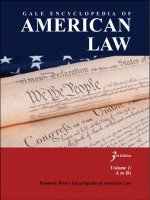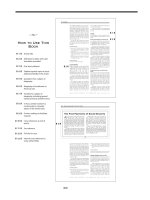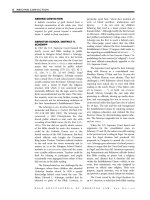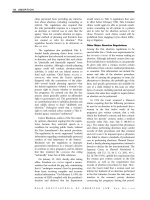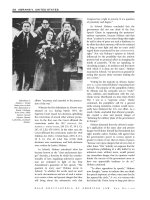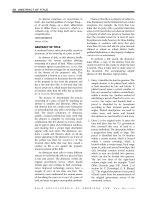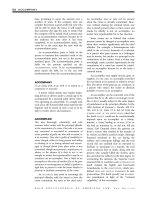Gale Encyclopedia Of American Law 3Rd Edition Volume 1 P3 ppsx
Bạn đang xem bản rút gọn của tài liệu. Xem và tải ngay bản đầy đủ của tài liệu tại đây (445.09 KB, 10 trang )
ABIDING CONVICTION
A definite conviction of guilt derived from a
thorough examination of the whole case. Used
commonly to instruct juries on the frame of mind
required for guilt proved beyond a reasonable
doubt. A settled or fixed conviction.
ABINGTON SCHOOL DISTRICT V.
SCHEMPP
In 1963 the U.S. Supreme Court banned the
Lord’s
PRAYER and Bible reading in public
schools in Abington School District v. Schem pp,
374 U.S. 203, 83 S. Ct. 1560, 10 L. Ed. 2d 844.
The decision came one year after the Court had
struck down, in
ENGEL V. VITALE, a state-authored
prayer that was recited by public school
students each morning (370 U.S. 421, 82 S.
Ct. 1261, 8 L. Ed. 2d 601 [1962]). Engel
had opened the floodgates; Schempp ensured
that a steady flow of anti-school prayer rulings
would continue into the future. Schempp was in
many ways a repeat of Engel: the religious
practices with which it was concerned were
nominally different, but the logic used to find
them unconstitutional was the same. This time,
the majority went one step further, issuing the
first concrete test for determining violations of
the First Amendment’s Establishment Clause.
The Schempp
RULING involved two cases: its
namesake and Murray v. Curlett, 228 Md. 239,
179 A.2d 698 (Md. 1962). The Schempp case
concerned a 1949 Pennsylvania law that
forced public schools to start each day with
a reading of ten Bible verses ( 24 P a. Stat . § 15-
1516). The law did not specify which version
of the Bible should be used—for instance, it
could be the Catholic Douay t ext or the
Jewish version of the Ol d Testament. But local
school officials only bought the Protestant
King James Version. Teachers ordered students
to rise and recite the verses reverently and in
unison, or, as in the Abington School District,
students in a
BROADCASTING class read the verses
over a public-address system. Teachers could be
fired for refusing to participate, and pupils
occasionally were segregated from others if they
did not join in the daily reading.
The Pennsylvania law was challenged by the
Schempps, whose three children also attended
Unitarian Sunday school. In 1958 a special
three-judge federal court heard the case. The
father, Edward L. Schempp, testified that he
objected to parts of the Bible. Leviticus, in
particular, upset him, “where they mention all
sorts of blood sacrifices, uncleanness and
leprosy. I do not want my children
believing that God is a lesser person than a
human father.” Although hardly the first lawsuit
on this issue—Bible reading cases in state courts
had yielded contradictory rulings since 1910—
Schempp was the first to reach a federal court.
The three-judge panel ruled that the Bible
reading statute violated the First Amendment’s
Establishment Clause (“Congress shall make no
law respecting an establishment of
RELIGION ”)
and interfered with its Free Exercise Clause (“or
prohibiting the free exercise [of religion]”). Local
and state officials immediately appealed to the
U.S. Supreme Court.
The Supreme Court agreed to hear Schempp
along with Murray as a consolidated case.
Madalyn Murray O’Hair and her 14-year-old
son, William Murray, were atheists. They had
challenged a 1905 Baltimore school board rule
requiring each school day to start with Bible
reading or the Lord’s Prayer (“Our father, who
art in heaven ”), or both. An
ATTORNEY
herself, Murray brought the suit only after
protesting to officials, stirring up media atten-
tion, and encouraging her so n to
PROTEST in a
controversial strike that kept him out of school
for 18 days. The suit said the rule transgressed
the Establishment Clause by requiring compul-
sory religious education and violated the Free
Exercise Clause by discriminating against athe-
ists. The Murrays originally lost in state courts
and on
APPEAL.
When the U.S. Supreme Court heard oral
arguments for the consolidated cases on
February 27 and 28, the nation was still reacting
to the previous year’s ruling in Engel. An uproar
over the Engel decision had produced 150
proposals in Congress to amend the
CONSTITU-
TION
. Schempp gave advocates of school prayer a
chance to argue that the Court had been wrong
in Engel, and this they did. Attorneys represent-
ing Pennsylvania and Baltimore officials denied
that Bible reading or prayer had a religious
nature, and claimed that it therefore did not
violate the Establishment Clause—which, in any
event, they maintained, was only designed to
prevent an official state religion. Their true
purpose, argued attorneys, was to keep order
and provide a proper moral climate for students.
The Court stood by the Engel decision. In
an 8–1 decision, it ruled that both Bible reading
GALE ENCYCLOPEDIA OF AMERICAN LAW, 3RD E DITION
8 ABIDING CONVICTION
and the Lord’s Prayer violated the Establish-
ment Clause. Justice Tom C. Clark’s majority
opinion differed in a few respects from the
previous year’s ruling: It admonished prayer
advocates for ignoring the law, spelled out in
some detail the precedents involved, and laid
out the Court’s first explicit test for Establish-
ment Clause questions. Founded on the idea of
state
NEUTRALITY, this test had a vital standard:
Any law hoping to survive the prohibitions of
the Establishment Clause must have “a secular
purpose and a primary effect that neither
advances nor inhibits religion.”
The test clearly spelled out the limits. Study
of the Bible or religion was acceptable, but
only so long as “presented objectively as part
of a secular program of education.” Religious
practices in public school were not allowed
under the
FIRST AMENDMENT. “While the Free
Exercise Clause clearly prohibits the use of
STATE
ACTION
to deny the rights of free exercise to
anyone,” Justice Clark observed, “it has never
meant that a majority could use the machinery
of the State to practice its beliefs.”
Schempp produced three concurring opi-
nions, notably a 74-page opinion by Justice
William J. Brennan Jr. As in Engel, the sole
dissent came from Justice
POTTER STEWART. Again
he disagreed with the majority’s emphasis on
the Establishment Clause’s taking precedence
over the Free Exercise Clause. For Stewart, the
key factor was whether the states in the case had
actually coerced students into praying or Bible
reading. He did not think so.
Schempp concluded the initial round of the
Supreme Court’s prayer ban. However, the issue
did not fade from public, political, and religious
concern, and it came before the Supreme Court
two decades later in
WALLACE V. JAFFREE, 472 U.S.
38, 105 S. Ct. 2479, 86 L. Ed. 2d 29 (1985) (a
one-minute period of silence for meditation or
prayer had no secular purpose and was created
with religious purpose).
The constitutionality of student-led
prayers made i ts way to the Supreme Court
in Sa nta Fe Independent School District v. Doe,
530 U.S. 290, 120 S. Ct. 2266, 147 L.Ed.2d 295
(2000). The Court held that a Texas public
school district could not let its students lead
prayers over the public-address system before
its high school football games. The school
district’ssponsorshipofthepublicprayersby
elected student representatives was unconsti-
tutional because the s chools could n ot coerce
anyone to support or participate in religion.
The Establishment Clause barred student
prayersaswellasthoseconductedbyclergy
at school events such as graduation (
LEE V.
WEISMAN, 505 U.S. 577, 112 S. Ct. 2649, 120 L.
Ed.2d 467 [1992]).
FURTHER READINGS
American Civil Liberties Union (ACLU). 2002. “The
Establishment Clause and Public Schools: An ACLU
Legal Bulletin.”
Blanshard, Paul. 1963. Religion and the Schools: The Great
Controversy. Boston: Beacon Press.
Brown, Steven P., and Cynthia J. Bowling. 2003. “Public
Schools and Religious Expression: The Diversity
of School Districts’ Policies Regarding Religious Expres-
sion.” Journal of Church and State 45, no. 2 (spring).
Davis, Derek H. 2003. “Moments of Silence in America’s
Public Schools: Constitutional and Ethical Con-
siderations.” Journal of Church and State 45, no. 3
(summer).
Drakeman, Donald L. 1991. Church-State Constitutional
Issues: Making Sense of the Establishment Clause.
Westport, CT: Greenwood.
Levy, Leonard W. 1994. The Establishment Clause: Religion
and the First Amendment. 2d ed. Chapel Hill: Univ. of
North Carolina Press.
“Religion and Schools.” 1994. Congressional Quarterly
(February 18).
Edward L. Schempp,
his wife, Sidney, and
two of his three
children, Roger and
Donna, challenged a
Pennsylvania law that
made Bible reading in
the state’s schools
compulsory.
AP IMAGES
GALE ENCYCLOPEDIA OF AMERICAN LAW, 3
RD E DITION
ABINGTON SCHOOL DISTRICT V. SCHEMPP 9
CROSS REFERENCES
Constitution al Amendment; Religion; Schools and School
Districts.
ABJURATION
A renunciation or abandonment by or upon oath.
The renunciation under oath of one’s citizenship
or some other right or privilege.
ABODE
One’s home; habitation; place of dwelling; or
residence. Ordinarily means “domicile.” Living
place impermanent in character. The place where
a person dwells. Residence of a legal voter. Fixed
place of residence for the time being. For service of
process, one’s fixed place of residence for the time
being; his or her “usual place of abode.”
ABOLITION
The destruction, annihilation, abrogation, or
extinguishment of anything, but especially things
of a permanent nature—such as institutions,
usages, or customs, as in the abolition of slavery.
In U.S.
LEGAL HISTORY, the concept of abolition
generally refers to the eighteenth- and nineteenth-
century movement to abolish the
SLAVERY
of African Americans. As a significant political
force in the pre-Civil War United States, the
abolitionists had significant effect on the U.S.
legal and political landscape. Their consistent
efforts to end the institution of slavery culmi-
nated in 1865 with the
RATIFICATION of the
Constitution’s
THIRTEENTH AMENDMENT, which
outlawed slavery. The abolitionist ranks encom-
passed many different factions and people of
different backgrounds and viewpoints, includ-
ing European and African Americans, radicals
Abode: Home Ownership vs. Rentals in the United States, 2008
SOURCE: U.S. Census Bureau, Housing Vacancy Survey, 2008.
Less than 62.0%
62.0 to 66.9%
67.0 to 69.9%
70.0% or higher
Home ownership rates by state
Hawaii
Ala
s
k
a
Montana
Washington
Oregon
California
Nevada
Idaho
Wyoming
Utah
Colorado
New
Mexico
Arizona
North Dakota
Minnesota
South Dakota
Nebraska
Kansas
Oklahoma
Texas
Wisconsin
Iowa
Missouri
Arkansas
Louisiana
Illinois
Michigan
Indiana
Ohio
Pennsylvania
New York
W.Va.
Virginia
N.Carolina
Kentucky
Tennessee
Miss.
Alabama
Georgia
S.Carolina
Florida
Maine
Vt.
N.H.
Mass.
R.I.
Conn.
N.J.
Del.
Md.
D.C.
Renters
28%
Homeowners
58%
Vacancies
14%
ILLUSTRATION BY GGS
CREATIVE RESOURCES.
REPRODUCED BY
PERMISSION OF GALE,
A PART OF CENGAGE
LEARNING.
GALE ENCYCLOPEDIA OF AMERICAN LAW, 3
RD E DITION
10 ABJURATION
and moderates. The motives of the abolitionists
spanned a broad spectrum, from those who
opposed slavery as unjust and inhumane to
those whose objections were purely economic
and focused on the effects that an unpaid
Southern workforce had on wages and prices in
the North.
Efforts to abolish slavery in America began
well before the Revolutionary War and were
influenced by similar movements in Gre at
Britain and France. By the 1770s and 1780s,
many antislavery societies, largely dominated by
Quakers, had sprung up in the North. Early
American leaders such as
BENJAMIN FRANKLIN,
ALEXANDER HAMILTON, JOHN JAY, and THOMAS PAINE
made known their opposition to slavery.
The early abolitionists played an important
role in outlawing slavery in Northern states
by the early nineteenth century. Vermont out-
lawed slavery in 1777, and Massachusetts
declared it
INCONSISTENT with its new state
CONSTITUTION, ratified in 1780. Over the next
three decades, other Northern states, including
Pennsylvania, New York, and New Jersey, passed
gradual
EMANCIPATION laws that freed all future
children of slaves. By 1804, every Northern state
had enacted some form of emancipation law.
In the South, where slavery played a far
greater role in the economy, emancipation moved
at a much slower pace. By 1800 all Southern states
except Georgia and South Carolina had passed
laws that eased the practice of private manumis-
sion—or the freeing of slaves by individual
slaveholders. Abolitionists won a further victory
in the early 1800s when the United States
outlawed international trade in slaves. However,
widespread
SMUGGLING of slaves continued.
During the first three decades of the 1800s,
abolitionists continued to focus largely on
gradual emancipation. As the nation expanded
westward, they also opposed the introduction of
slavery into the western territories. Although
abolitionists had won an early victory on
this front in 1787, when they succeeded in
prohibiting slavery in the Northwest Territory,
their efforts in the 1800s were not as completely
successful. The
MISSOURI COMPROMISE OF 1820
(3 Stat. 545), for example, stipulated that
slavery would be prohibited only in areas of
the
LOUISIANA PURCHASE north of Missouri’s
southern boundary, except for Missouri itself,
which would be admitted to the Union as a
slave state. Slavery in the territories remained
one of the most divisive issues in U.S. politics
until the end of the
CIVIL WAR in 1865 .
Beginning in the 1830s, evangelical Chris-
tian groups, particularly in New England,
brought a new radicalism to the cause of
abolition. They focused on the sinfulness of
slavery and sought to end its practice by
appealing to the consciences of European
Americans who supported slavery. Rather than
endorsing a gradual emancipation, these new
abolitionists called for the immediate and
complete emancipation of slaves witho ut com-
pensation to slaveowners. Leaders of this
movement included
WILLIAM LLOYD GARRISON,
founder of the abolitionist newspaper the
Liberator;
FREDERICK DOUGLASS, a noted African
American writer and orator; the sisters Sarah
Moore Grimké and Angelina Emily Grimké,
lecturers for the American Anti-Slavery Society
and pioneers for women’s rights; Theodore
Dwight Weld, author of an influential antislav-
ery book, American Slavery as It Is (1839); and
later,
HARRIET BEECHER STOWE, whose 1852 novel
Uncle Tom’s Cabin was another important
abolitionist tract.
In 1833 this new generation of abolitionists
formed the American Anti-Slavery Society
(AAS). The organization grew quickly, particu-
larly in the North, and by 1840 had reached a
height of 1,650 chapters and an estimated
130,000 to 170,000 members. Nevertheless,
abolitionism remained an unpopular cause even
in the North, and few mainstream politicians
openly endorsed it.
To achieve its goals, the AAS undertook a
number of large projects, many of which were
Members of the
Pennsylvania
Abolition Society
(seated, far right,
William Lloyd
Garrison, founder
of The Liberator,
an abolitionist
newspaper).
NATIONAL PORTRAIT
GALLERY
GALE ENCYCLOPEDIA OF AMERICAN LAW, 3
RD E DITION
ABOLITION 11
frustrated by Southern opposition. For example,
the organization initiated a massive postal
campaign designed to
APPEAL to the moral
scruples of Southern slaveowners and voters.
The campaign flooded the South with antislav-
ery tracts sent through the mails. Although a
law that would have excluded antislavery
literature from the mails was narrowly defeated
in Congress in 1836, pro-slavery forces, with the
help of President Andrew Jackson’s administra-
tion and local postmasters, effectively ended the
dissemination of abolitionist literature in the
South. The AAS was similarly frustrated when it
petitioned Congress on a variety of subjects
related to slavery. Congressional gag rules
rendered the many aboliti onist petitions impo-
tent. These rules of
LEGISLATIVE procedure
allowed Congress to table and effectively ignore
the antislavery petitions.
By the 1840s the evangelical abolitionist
movement had begun to break up into different
factions. These factions differed on the issue of
gradual versus radical change and on the
inclusion of other causes, including w omen’s
rights, in their agendas. Some abolitionists
decided to form a political party. The Liberty
party, as they named it, nominated James G.
Birney for U.S. president in 1840 and 1844.
When differences later led to the dissolution of
the Liberty party, many of its members created
the
FREE SOIL PARTY, which took as its main cause
opposition to slavery in the territories newly
acquired from Mexico. They were joined by
defecting Democrats who were disgruntled with
the increasing dom ination of Southern interests
in their party. In 1848 the Free Soil party
nominated as its candidate for U.S. president
MARTIN VAN BUREN, who had served as the eighth
PRESIDENT OF THE UNITED STATES from 1837 to
1841, but Van Buren did not win. (
ZACHARY
TAYLOR
won the election.)
After passage of the
FUGITIVE SLAVE ACT OF
1850 (9 Stat. 462), which required Northern
states to return escaped slaves and imposed
penalties on people who aided such runaways,
abolitionists became actively involved in the
Underground Railroad, a secretive network that
provided food, shelter, and direction to escaped
slaves seeking freedom in the North. This
network was largely maintained by free African
Americans and is estimated to have helped
50,000 to 100,000 slaves to freedom. Harriet
Tubman, an African American and ardent
abolitionist, was one organizer of the Under-
ground Railroad. During the 1850s she bra vely
traveled into South ern states to help other
African Americans escape from slavery, just as
she had escaped herself.
Whereas the vast majority of abolitionists
eschewed violence,
JOHN BROWN actively partici-
pated in it. In response to attacks led by
pro-slavery forces against the town of Lawrence,
Kansas, Brown, the leader of a Free Soil
MILITIA,
led a reprisal attack that killed five pro-slavery
settlers in 1856. Three years later, he undertook
an operation that he hoped would inspire
a massive slave rebellion. Brown and 21
followers began by capturing the U.S. arsenal
at Harpers Ferry, Virginia (now West Virginia).
Federal forces under Robert E. Lee promptly
recaptured the arsenal, and Brown was hanged
shortly thereafter, becoming a martyr for the
cause.
In 1854 abolitionists and Free Soi lers joined
with a variety of other interests to form
the
REPUBLICAN PARTY, which successfully stood
ABRAHAM LINC OLN for president in 1860. Al-
though the party took a strong stand against
the introduction of slavery in the territories,
it did not propose the more radical option of
immediate emancipation. In fact, slavery ended
as a result of the Civil War, which lasted from
1861 to 1865. Not a true aboliti onist at the start
of his presidency, Lincoln became increasingly
receptive to antislavery opinion. In 1863 he
announced the
EMANCIPATION PROCLA MATION,
which freed all slaves in areas still engaged in
revolt against the Union. The
PROCLAMATION
served as an important symbol of the Union’s
new commitment to ending slavery. Lincoln
This frontispiece
illustration, entitled
“A Slave Father Sold
Away from His
Family,” is from the
Child’s Antislavery
Book (1860). The
book was distributed
by the Sunday School
Union in an effort to
alert children to the
horrors of slavery.
CORBIS.
GALE ENCYCLOPEDIA OF AMERICAN LAW, 3
RD E DITION
12 ABOLITION
later supported the ratification of the Thirteenth
Amendment, which officially abolished slavery
in the United States.
After the war, former abolitionists, includ-
ing radical Republicans such as Senator
CHARLES SUMNER (R-Mass.), continued to lobby
for
CONSTITUTIONAL amendments that would
protect the rights of the newly freed slaves,
including the
FOURTEENTH AMENDMENT, ratified in
1868, which guaranteed citizenship to former
slaves and declared that no state could “deprive
any person of life, liberty, or property, without
DUE PROCESS OF LAW; nor deny to any person
the
EQUAL PROT ECTION of the laws.” Former
abolitionists also lobbied, albeit unsuc-
cessfully, for land redistribution that would
have given ex-slaves a share of their former
owners’ land.
FURTHER READINGS
Edwards, Judith. 2004. Abolitionists and Slave Resistance:
Breaking the Chains of Slavery. Berkeley Heights, NJ:
Enslow.
Greenburg, Martin H., and Charles G. Waugh, eds. 2000.
The Price of Freedom: Slavery and the Civil War.
Nashville: Cumberland House.
Hessler, Katherine. 1998. “Early Efforts to Suppress Protest:
Unwanted Abolitionist Speech.” Boston Univ. Public
Interest Law Journal 7 (spring).
Klingaman, William K. 2001. Abraham Lincoln and the Road
to Emancipation, 1861–1865. New York: Viking.
Merrill, Walter M. 1971. Against the Wind and Tide: A
Biography of William Lloyd Garrison. Cambridge, MA:
Harvard Univ. Press.
Tackach, James. 2002. The Abolition of American Slavery. San
Diego: Lucent.
CROSS REFERENCES
Compromise of 1850; Dred Scott v. Sandford; Emancipation
Proclamation; Fourte enth Amendment; Fugit ive Slave Act
of 1850; Lincoln, Abraham; Missouri Compromise of 1820;
Prigg v. Pennsylvania; Slavery; Sumner, Charles; Thirteenth
Amendment.
ABORTION
An abortion is the spontaneous or artificially
induced expulsi on of an embryo or fetus. As used
in legal context, the term usually refers to induced
abortion.
History
English COMMON LAW generally allowed abortion
before the “quickening” of the fetus (i.e., the
first recognizable movement of the fetus in the
uterus), which occurs between the sixteenth and
eighteenth weeks of pregnancy. After quicken-
ing, however, common law was less clear as to
whether abortion was a crime. In the United
States, state legislatures did not pass abortion
statutes until the nineteenth century. After 1880
abortion was criminalized by statute in every
state of the Union, owing in large measure to
strong anti-abortion positions taken by the
AMERICAN MEDICAL ASSOCIATION (AMA). Despite
the illegality, many thousands of women every
year sought abortions. Under a heavy cloak of
shame and secrecy, these abortions were
performed in unsafe conditions, and many
women died or suffered medical complications
from the procedures.
The abortion laws developed in the late
nineteenth century existed largely unchanged
until the 1960s and 1970s, when a number of
different circumstances combined to bring
about a movement for their reform. Women’s
rights groups, doctors, and lawyers began an
organized abortion reform movement to press
for changes, in part because many of them had
witnessed the sometimes deadly maternal com-
plications resulting from illegal abortions.
Women’s organizations also began to see
abortion reform as a crucial step toward the
goal of equality between the sexes. They argued
that women must be able to control their
pregnancies in order to secure equal status. In
addition, new concerns regarding explosive
population growth and its effect on the
environment increased public awareness of the
need for
BIRTH CONTROL. At the same time, many
other countries developed far more permissive
Two police officers
arrest one of many
protestors
partcipating in a
pro-life sit-in during
the 2008 Democratic
National Convention
in Denver, Colorado.
DOUG PENSINGER/GETTY
IMAGES
GALE ENCYCLOPEDIA OF AMERICAN LAW, 3
RD E DITION
ABORTION 13
laws regarding abortion. In Japan and Eastern
Europe, abortion was available on demand, and
in much of Western Europe, abortion was
permitted to protect the mother’s health.
Public awareness of the abortion issue also
increased through two incidents in the early
1960s that caused a greater number of children
to be born with physical defects. In 1961 the
drug thalidomide, used to treat nausea during
pregnancy, was found to cause serious birth
defects. A three-year (1962–1965) German
measles epidemic caused an estimated 15,000
children to be born with defects. Pregnant
women who were affected by these incidents
could not seek safe abortions because of the
strict laws then in existence.
Reacting to these and other developments,
and inspired by the successes of the
CIVIL RIGHTS
MOVEMENT
of the 1950s and 1960s, women’s
rights organizations, including the
NATIONAL
ORGANIZATION FOR WOMEN
(NOW), formed in
1966, sought to reform abortion laws through
LEGISLATION and lawsuits. The organization
hoped to educate a male-dominated legal and
judicial profession about this important issue
for women. This effort, supported by such
groups as the
AMERICAN CIVIL LIBERTIES UNION
(ACLU), quickly began to have an effect.
Between 1967 and 1970, 12 states adopted
abortion reform legislation. However, abortion
activist groups began to see the abortion issue as
a question of social justice and to press for more
than reform. Under the rallying cry of “repro-
ductive freedom,” they began to demand an
outright
REPEAL of existing state laws and
unobstructed access for women to legal abortion.
The increase in abortion-related cases be-
fore the courts eventually resulted in the need
for clarification of the law by the Supreme
Court. After considering many abortion-related
appeals and petitions, on May 31, 1971, the
Court accepted two cases,
ROE V. WADE, 410 U.S.
113, 93 S. Ct. 705, 35 L. Ed. 2d 147 (1973) and
Doe v. Bolton, 410 U.S. 179, 93 S. Ct. 739, 35 L.
Ed. 2d 201 (1973), for hearing.
Roe v. Wade and Doe v. Bolton
Although the two cases before the Court
appeared by their titles to involve the fates of
two individuals,
ROE and Doe, in reality both
suits were brought by many people representing
many different interests. Roe v. Wade was
argued on behalf of all women of the state of
Texas; in legal terminology, it was a
CLASS ACTION
suit. Thirty-six abortion reform groups filed
briefs, or reports, with the Court on Roe’s
Pro-life supporters
march past the
Supreme Court
during the annual
March for Life event.
AP PHOTOS.
GALE ENCYCLOPEDIA OF AMERICAN LAW, 3RD E DITION
14 ABORTION
behalf. These included women’s, medical,
university, public health, legal, WELFARE, church,
population control, and other groups. The anti-
abortion side of the case in cluded representa-
tives from seven different anti-abortion groups
and the attorneys general of five states.
Roe involved a person using the pseudonym
Jane Roe—actually Norma McCorvey, who
revealed her identity in 1984. Roe, an unmar-
ried, pregnant woman from Texas, wanted to
have an abortion, but an existing abortion
statute prevented her from doing so. The Texas
statute, originally passed in 1857, outlawed
abortion except to save the mother’s life. Roe
filed a lawsuit in federal district court on behalf
of herself and all other pregnant women. She
sought to have the abortion statute declared
unconstitutional as an invasion of her right to
PRIVACY as protected by the First, Fourth, Fifth,
Ninth, and Fourteenth Amendments in
GRIS-
WOLD V
. CONNECTICUT, 381 U.S. 479, 513, 85
S. Ct. 1678, 14 L. Ed. 2d 510 (1965). She also
sought to have an injunction, or court order,
issued against the statute’s enforcement so that
she might go forward with the abortion. The
abortion reform movement attached two other
cases to Roe ’s in an attempt to represent a wider
range of the interests involved in the issue. The
physician James Hallford, who was being
prosecuted under the statute for two abortions
he had performed, also filed suit against the
Texas law, as did a childless couple, the Does.
The three-judge district court combined
Roe’s case with the cases of Hallford and the
Does, but later dismissed the suit brought by the
Does on the grounds that neither had violated
the law and the woman was not pregnant. The
district court agreed with Roe that the law w as
unconstitutionally vague and violated her right
to privacy under the
NINTH AMENDMENT, which
allows for the exist ence of rights, such as that of
privacy, not explicitly named in the Constitu-
tion’s
BILL OF RIGH TS, and the FOURTEENTH
AMENDMENT
. It refused, however, to grant the
injunction, allowing her to go ahead with
the abortion. Roe then appealed the denial of
the injunction to the U.S. Supreme Court.
Doe v. Bolton involved a 1968 Georgia statute
that allowed abortion if necessary to save the
mother’s life, in the case of pregnancy resulting
from
RAPE or INCEST, or if the baby was likely to
be born with serious birth defects (Ga. Crim.
Code § 26-1202 a, b). However, the statute also
created procedural requirements that effectively
would have allowed few abortions. Those
requirements included hospital accreditation,
committee approval, two-doctor agreement,
and state residency. The case concerned Mary
Doe, who had sought an abortion at Grady
Memorial Hospital in Atlanta. She claimed that
she had been advised that pregnancy would
endanger her health, but the hospital’s Abortion
Rights Committee denied her the abortion. She
sought a DECLARATORY JUDGMENT, holding that the
Georgia law unconstitutionally violated her right
to privacy as well as her Fourteenth Amendment
guarantees of due process and
EQUAL PROTECTION.
She also sought an injunction against the law’s
enforcement.
Roe and Doe were filed in March and April
1970, and the women’s pregnancies would not
have lasted through December 1970. The Court
heard the cases in December 1971 and October
1972, and they were not resolved until January
1973, when the Court announced its decisions.
In Roe, the Court, on a 7–2 vote, found the
Texas abortion statute unconstitutional. In its
opinion, written by Justice
HARRY A. BLACKMUN,
the Court held that the law violated a right to
privacy guaranteed by the due process clause of
the Fourteenth Amendment. However, the
Court further held that such a right is a
“qualified” one and subject to regulation by
the state. The state has “legitimate interests in
protecting both the pregnant woman’s health
and the potentiality of human life” (i.e., the life
of the fetus). To specify when the state’s
interests emerge, the Court divided pregnancy
On January 22, 2005,
supporters of Roe v.
Wade gather outside
the Supreme Court
building to
commemorate the
33rd anniversary of
the Court’s decision to
legalize abortion.
AP PHOTO/PABLO
MARTINEZ MONSIVAIS
GALE ENCYCLOPEDIA OF AMERICAN LAW, 3
RD E DITION
ABORTION 15
into twelve-week trimesters. In the first trimes-
ter, the state cannot regulate abortion or
prevent a woman’s access to it. It can only
require that abortions be performed by a
licensed physician and under medically safe
conditions. During the second trimester, the
state can regulate abortion procedures as long as
the regulations are reasonably related to the
promotion of the mother ’s health. In the third
trimester, the state has a dominant interest in
protecting the “potentiality” of the fetus’s life.
A state may prohibit abortions during this time
except in cases where they are essential to
preserve the life or health of the mother. The
Court also cited judicial precedent in holding
that the fetus is not a “person” as defined by the
Fourteenth Amendment.
In Doe, the Court found the Georgia statute
to be unconstitutional as well, holding that it
infringed on privacy and personal liberty by
permitting abortion only in restricted cases. The
Court ruled further that the statute’s four
procedural requirements—hospital accredita-
tion, hospital committee approval, two-doctor
agreement, and state residency—violated the
CONSTITUTION. The state could not, for example,
require that abortions be performed only at
certain hospitals, because it had not shown that
such restrictions advanced its interest in pro-
moting the health of the pregnant woman. Such
a requirement interfered with a woman’s right
to have an abortion in the first trimester of
pregnancy, which the Court in Roe had declared
was outside the scope of state regulation.
After Roe v. Wade
After the Supreme Court decisions in Roe v.
Wade and Doe v. Bolton, states began to
liberalize their abortion laws. However, abor-
tion quickly became a divisive political issue
for Americans. Grassroots opposition to
abortion—supported by such influential insti-
tutions as the Catholic Church—was strong
from the start. By the early 1980s, the anti-
abortion movement had become a powerful
political force.
President
RONALD REAGAN strongly opposed
abortion and used his administration to try to
change abortion rulings. He appointed a
SURGEON GENERAL, C. Everett Koop, who opposed
abortion, and Reagan made it a top priority of
his
JUSTICE DEPARTMENT to effect a reversal of Roe.
Reagan even published a book on the subject in
1984, Abortion and the Conscience of a Nation,
which contains many of the essential positions
of the anti-ab ortion movement. Reagan argued
that the fetus has rights equal to those of people
who are already born. He also cited figures
indicating that 15 million abortions had been
performed since 1973, and he stated his belief
that the fetus experienced great pain as a result
of the abortion procedure. He quoted a
statement by Mother Teresa, the famed nun
who helped the poor of Calcutta: “The greatest
misery of our time is the generalized abortion of
children.” Whereas abortion rights, or pro-
choice, advocates argued that there were public
health advantages of the new abortion laws,
opponents of abortion, such as Reagan, referred
to abortion as a “silent holocaust.”
The anti-abortion, or pro-life, movement
has challenged abortion in a number of
different ways. It has sponsored
CONSTITUTIONAL
amendments that would effectively reverse Roe,
as well as legislation that would limit and
regulate access to abortion, including govern-
ment financing of abortion procedures. Some
anti-abortion groups have practiced
CIVIL DIS-
OBEDIENCE
, attempting to disrupt and block
abortion cli nic activities. The most extreme
opponents have resorted to violence and even
MURDER in an attempt to eliminate abortion.
All these methods have resulted in a great
deal of
LITIGATION and added to the complexity
of the abortion issue. Many of the subsequent
cases have come before the Supreme Court.
Observers have often expected the Court to
overturn its Roe decision, particularly after
the Reagan administration appointed three
justices to the Court. However, although
the Court allowed increasingly strict state
regulation of abortion after Roe, it stuck to the
essential finding in the case that women have
a limited right to terminate their pregnancies.
This entitlement is incorporated in the
right of privacy guaranteed by the Fou rteenth
Amendment.
Constitutional Amendments Although amend-
ing the Constitution is the most direct way to
reverse Roe v. Wade, neither Congress nor the
states have passed a
CONSTITUTIONAL AMENDMENT
related to the issue of abortion. The anti-abortion
forces have found it extremely difficult to achieve
a public consensus on this divisive issue.
However, at least 19 state legislatures have passed
applications to convene a constitu tional conven-
tion to propose an amendmen t that w ould
GALE ENCYCLOPEDIA OF AMERICAN LAW, 3RD E DITION
16 ABORTION
outlaw abortions. Congressional representatives
have also worked to bring such an amendment
about. The many dozens of amendments that
have been proposed can be grouped into two
main categories: states’ rights and the right to life.
The former would restore to the states the
same control over abortion that they exercised
prior to Roe. The latter would designate the
fetus as a person, entitled to all the privileges and
rights guaranteed under the Fourteenth
Amendment.
One unsuccessful attempt at changing the
Constitution was the Hatch amendment of 1983,
sponsored by Senator Orrin G. Hatch (R-Utah),
which stated, “A right to abortion is not secured
by this Constitution.” It did not receive the two-
thirds majority necessary in Congress to be
submitted to the states for
RATIFICATION.
Congress has also sponsored legislation that
would effectively reverse Roe. For example, the
Human Life Bill (S. 158), introduc ed by Senator
JESSE HELMS (R-N.C.) in 1981, would have
established that the fetus is a person, entitled
to the full rights and privileges guaranteed by
the Fourteenth Amendment. The bill did not
pass, and it is doubtful whether Congress has
the constitutional authority to overturn a
Supreme Court precedent without violating
the
SEPARATION OF POWERS.
Federal F inancing In 1976 Representative
Henry J. Hyde (R-lll.) sponsored an amendment
to the
FEDERAL BUDGET appropriations bill for the
DEPARTMENT OF HEALTH AND HUMAN SERVICES (HHS).
His amendment denied
MEDICAID funding for
abortion unless the woman’s life is in danger or
she is pre gnant as a result of rape or incest, but
only if the woman reports the incident at the time
of its occurrence. Despite opposition from pro-
abortion groups, Hyde attached this amendment
every year to the same appropriations bill. The
Supreme Court has upheld the constitutionality
of the Hyde amendment (Harris v. McRae, 448 U.
S. 297, 100 S. Ct. 2671, 65 L. Ed. 2d 784 [1980];
McGowan v. Maryland, 366 U.S. 420, 81 S. Ct.
1101, 6 L. Ed. 2d 393 [1961]). Evidence suggests
that these federal actions have caused fewer
women to have abortions.
In the late 1980s, with its composition
having been changed by three Reagan appoin-
tees (Justices Sandra Day O’Connor,
ANTONIN
SCALIA
, and ANTHONY M. KENNEDY), the Court
issued a
RULING related to federal financing
of abortion that many perceived as a dramatic
shift against abortion rights. In
WEBSTER V.
REPRODUCTIVE HEALTH SERVICES, 492 U.S. 490,
109 S. Ct. 3040, 106 L. Ed. 2d 410 (1989), the
Supreme Court upheld a Missouri law prohibit-
ing the use of public funds and buildings for
abortion procedures and counseling, including
a provision that required fetal testing for
viability for abortions performed after the
twentieth week of pregnancy (Mo. Rev. Stat.
§§ 1.205.1, 1.205.2, 188.205, 188.210, 188.215).
Scalia, appointed in 1986, argued in his
concurring opinion that Roe v. Wade should
be overruled and that the Court had missed an
opportunity in not doing so in this case.
The Webster decision resulted in a flood of
new state legislation related to abortion. Many
states sought to reactivate old abortion laws that
had never been taken off the books subsequent to
Roe. Louisiana, for example, sought to reinstate
an 1855 law making all abortions illegal and
imposing a ten-year sentence on doctors and
women violating it. However, in January 1990 a
federal district court ruled that the 1855 law
could not be reinstated and that subsequent laws
allowing abortions in certain circumstances took
precedence (Weeks v. Connick, 733 F. Supp. 1036
[E.D. La. 1990]). By mid-1991, Pennsylvania,
Guam, Utah, and Louisiana had all enacted laws
banning abortions except in limited circum-
stances. Pennsylvania became the first to approve
new abortion restrictions when it amended its
Abortion Control Act (Pa. Cons. Stat. Ann. §
3201) to create strict new regulations on abortion
procedures (see the discussion of Planned
Parenthood of Southeastern Pennsylvania v. Casey
under “Other Major Abortion Regulations,” later
in this entry). In other states such as South and
North Dakota, legislation that would have
sharply restricted abortion was only narrowly
defeated. However, some states, including Con-
necticut and Maryland, reacted to the Webster
decision by passing legislation prote cting
women’s rights to abortion.
Before the Court ruled on Pennsylvania’s
Abortion Control Act, it decided a major case
relating to federal funding and regulatio n of
family planning clinics. In Rust v. Sullivan, 500
U.S. 173, 111 S. Ct. 1759, 114 L. Ed. 2d 233
(1991), the Court upheld a series of regulatio ns
issued in 1988 by the Reagan administration’s
Justice Department affecting family planning
clinics that receive funds through Title X of the
PUBLIC HEALTH SERVICE Act of 1970, 42 U.S.C. §§
300 to 300a-6. The regulations prohibited
GALE ENCYCLOPEDIA OF AMERICAN LAW, 3RD E DITION
ABORTION 17

